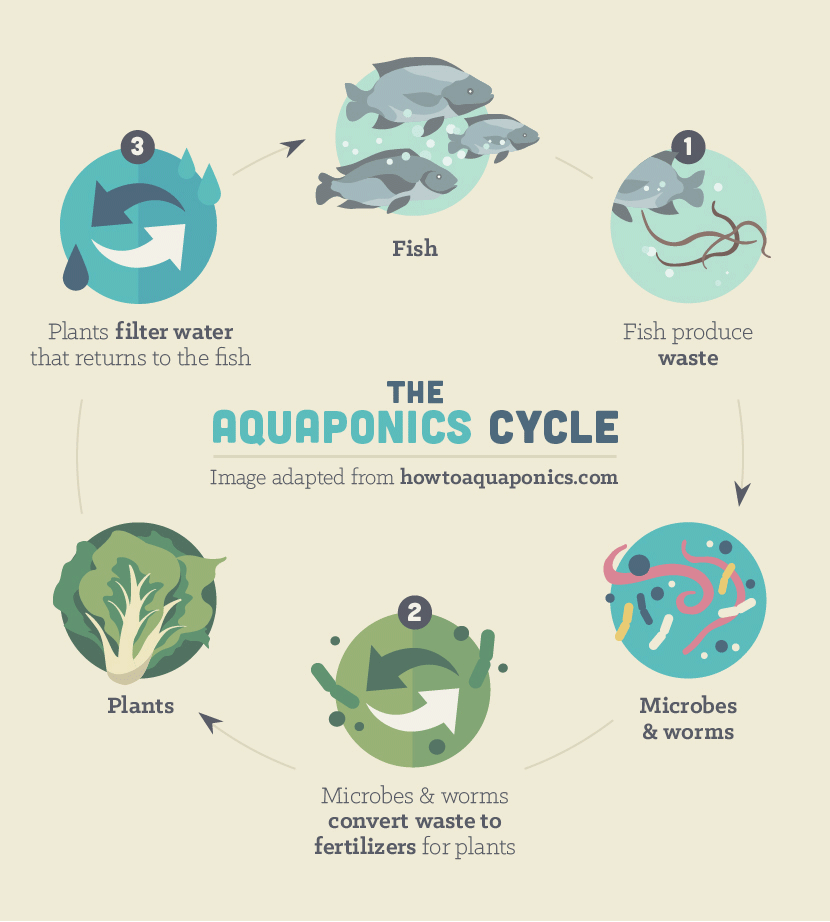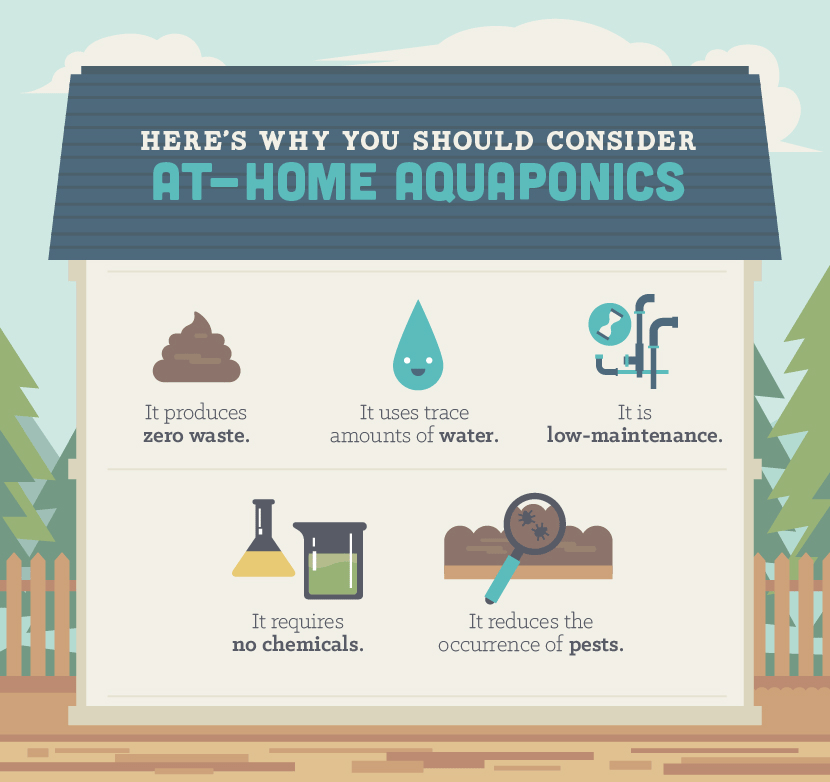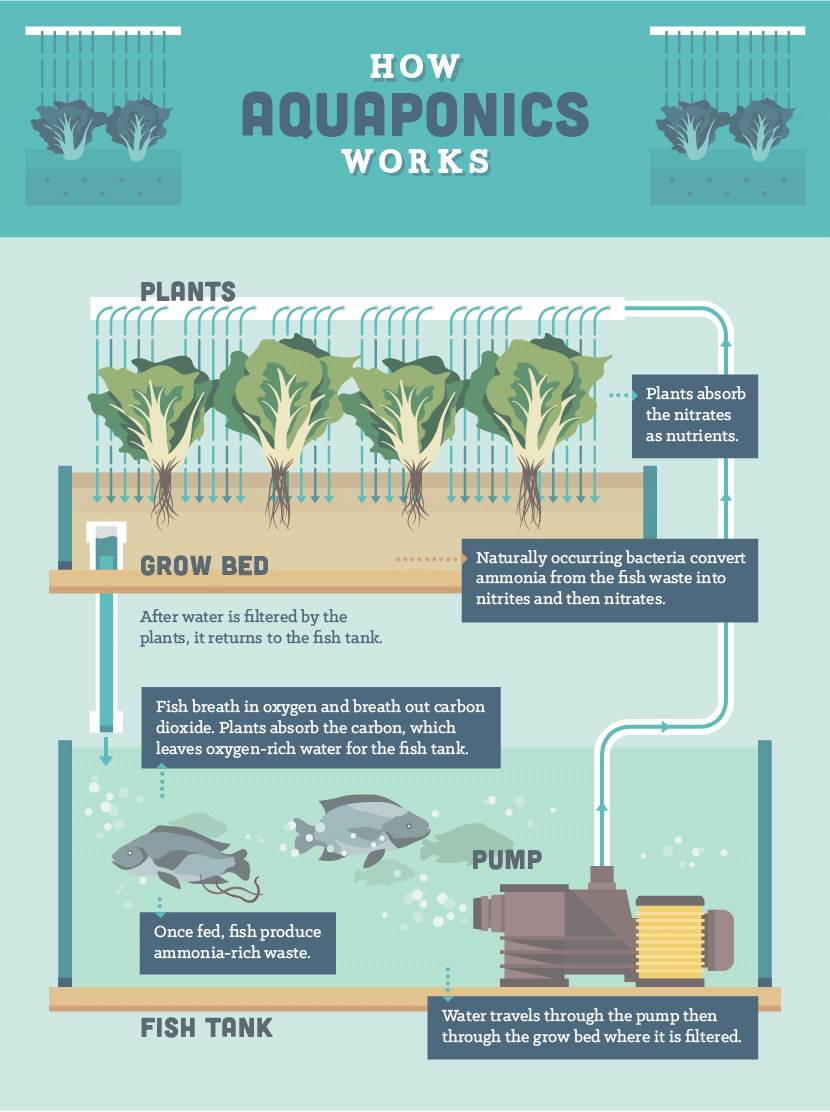By the middle of the century, there will be nearly 10 billion people competing for the Earth’s natural resources, which are vanishing at an astonishing rate. Consider that eight of the world’s 37 largest aquifers – which provide the fresh water necessary for life to exist – are overstressed, while an additional five are extremely stressed. And they can’t be replenished; that water is gone.
Luckily, compared to our ancestors, we are capable of great efficiency when it comes to meeting certain basic needs. In addition to cutting-edge irrigation technologies that reduce water waste, we have devised countless ways to lower water dependency and the amount of land required to provide food.
Growing crops hydroponically, for instance, requires no soil and minimal water, while aquaculture allows us to grow a valuable source of animal protein quickly in a relatively small space without plundering the oceans…

Aquaponics, on the other hand, is probably the most efficient method of growing food today. By combining aquaculture and hydroponics with a closed-loop system that results in zero waste, recycles water almost infinitely, and removes the use of fertilizers or chemicals, this ingenious methodology produces roughly one pound of fish for every 10 gallons of water.
While aquaponics systems are often used in commercial settings, smaller-scale systems are great for people who want a sustainable way to grow their own food at home year-round.
The Benefits of Aquaponics Abound

It Produces Zero Waste
When growing fish in a controlled environment, their waste has to be removed or the buildup of ammonia could poison them. Instead of pouring that waste back into the environment, it is fed through a filtration system to remove solids, and then through soilless beds of an aquaponics system where it delivers nutrients to plants’ roots. By the time the water cycles back to the recirculating aquaculture system where the fish live, it’s clean and ready to be used again.
It Uses Trace Amounts of Water
Once the original water has been added to the tanks (most experts recommend first-timers start with a 55- to 225-gallon bin for the fish), this zero-waste ecosystem only loses small amounts of water through transpiration and evaporation. Thereafter, a slight top-off approximately once a week or so should keep water levels in check. Compare this to a plot of land that needs regular irrigation, or an aquaculture system that has to be replenished on a continual basis to ensure fish don’t perish from their own waste.
It Is Low-Maintenance
Once it’s set up, most people only spend five to 10 minutes a day tending to their aquaculture system. Once a week, make sure to check pH and ammonia levels and clean some of the components. Otherwise you can forget weeding, straining your back, or skinning your knees, and donate the tools you’ve collected for tilling soil. Aquaponics is incredibly self-sustaining if set up correctly.
It Requires No Chemicals
Most industrial food systems require huge inputs of fertilizer and pesticides to grow, which can harm the environment. The Union for Concerned Scientists published a report about conventional farming in which they expressed grave concern about our overuse of chemicals to grow food. They describe how chemical fertilizer runoff adds to global warming emissions and creates “oxygen-deprived ‘dead zones’ at the mouths of major waterways,” among other things.
Perhaps the best part of aquaponics is its versatility. Just about anyone with space can grow fruit, fish, herbs, and vegetables at home. Or, if you are short on time and nervous about creating the required balance to ensure the fish don’t grow so fast that the system can’t sustain itself, you can purchase automated systems like the Grove.
It Reduces the Occurrence of Pests
Closely linked to the absence of chemicals is the absence of pests. Since aquaponics doesn’t require soil, it reduces the presence of the kinds of critters that can compromise your hard-earned crops. Root rot is less common as well, provided the water drains properly.
DIY Plans and Tips

Every aquaponics system includes a few basic components.
Fish
First, you have to decide what kind of fish you want to raise, which largely depends on where you live. If you live in a warm environment, choose fish that thrive in warmer water. You can manipulate a colder environment by building your aquaponics system inside a greenhouse that traps heat inside.
Common species for aquaponics systems include tilapia, trout, koi, catfish, carp, perch, barramundi, and goldfish. Some systems include mollusks and crustaceans. That said, certain fish are considered invasive, in part because they grow so rapidly that they tend to overwhelm an ecosystem. In this case, it may not be legal to keep them, so it’s important to check local laws before you purchase fish.
Seeds
Once you decide what species you plan to raise, it’s time to choose which plants to grow. Most people successfully grow herbs such as basil and mint, and leafy vegetables such as kale, lettuce, and chard. It’s also possible to grow fruit, including blueberries, tomatoes, and pomegranates. The general rule of thumb: The more nutrients a plant requires to grow, the bigger and more productive the aquaponics system needs to be.
Tank
Some people arrange their aquaponics system vertically, while others set it up horizontally. It really depends on the available space. The most important thing to consider is that you have enough water for your fish; the more the better, so they have space to swim comfortably. The tank could be a clean, recycled food barrel or a glass aquarium. Whatever you use, it’s important to monitor how quickly the fish reproduce and perhaps sell the fingerlings when you’re at capacity. You want your tank to be clean and humane – not only for the welfare of the fish, but for your aesthetic enjoyment as well.
Pumps
An aquaponics system requires an aerator to provide oxygen for the fish and a pump to send water from the fish tank to the filtration system to the grow bed and back again (unless you use gravity for the water’s return journey). Solar-powered pumps will take your aquaponics game to a whole new level of sustainability and reduce your energy consumption. You also need PVC pipes to pump the nutrient-dense water through (make sure they are non-toxic before installing).
Grow Bed
The grow beds can vary in structure and appearance, but one popular option is to use shallow wooden boxes lined with pond liner and perlite, gravel, or another soilless medium with excellent moisture retention and enough structure to provide plant support. An optional addition would be a bell siphon, which allows water to fill the grow bed to an optimal level, then uses air pressure to rapidly drain that water at the right time to prevent the roots from drowning.
Sun
Once you collect all the components, construct your system in a flat area that receives plenty of natural sunlight. Depending on your particular climate and the fish you choose, you should monitor temperature accordingly. Tilapia, for example, prefer water temperatures ranging from 72 to 90 degrees Fahrenheit. Temperatures below 70 degrees inhibit growth, and anything below 55 degrees could kill them.
Other Tips
How much you feed your fish depends largely on how fast you want them to grow and how quickly your system can filter. Brian Barth, an urban farming specialist and co-founder of Urban Agriculture Inc., recommends feeding fish as much as they are able to consume in 20 minutes, three times a day. You’ll also want to ensure you source only organic fish feed.
If you don’t want to build a DIY aquaponics system, you can purchase a variety of modular kits that cater to different needs. The Aquaponics Source provides everything from small ornate water fountains that double as a food production system to large kits built inside a 320-square-foot greenhouse.
It takes practice to get the balance right, but once you do you will enjoy the delicious benefits of a sustainable system that provides year-round sustenance and nutrition (via Fix).
If you’d like more information about setting up your own successful Aquaponics growing system click here. If you like this idea, be sure to share it with your friends and inspire someone you know. Anything becomes possible with just a little inspiration…


